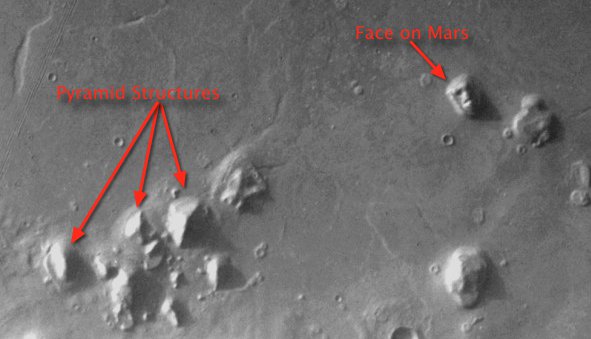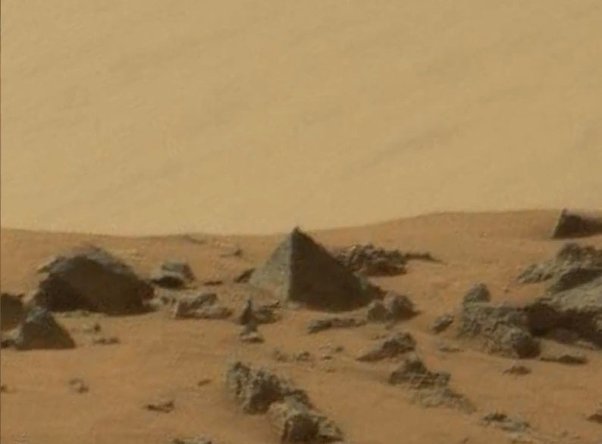Mars, often referred to as the Red Planet, has been a subject of fascination and speculation for centuries. With its striking surface features and potential for harboring life, Mars has captivated the imagination of scientists and the general public alike. Recently, intriguing images from Mars have sparked debates about the existence of pyramidal structures on its surface. Could these formations be evidence of ancient civilizations, or are they merely natural geological formations? Let’s delve into the evidence and theories surrounding the potential discovery of pyramids on Mars.

### **The Initial Discoveries**
The speculation about pyramids on Mars began with images captured by the Viking 1 Orbiter in 1976. Among these images, one in particular showed a formation in the Cydonia region that resembled a human face, which quickly became known as the “Face on Mars.” Nearby, other formations appeared to have symmetrical shapes reminiscent of pyramids. These images led to widespread excitement and speculation about the possibility of ancient Martian civilizations.

### **Cydonia: The Heart of the Controversy**
Cydonia, a region in the northern hemisphere of Mars, is the epicenter of the pyramid speculation. The initial images from Viking 1 revealed several formations that appeared to have straight edges and angular shapes. Some researchers and enthusiasts argued that these features could not be natural and must be the remnants of ancient structures built by intelligent beings. The supposed pyramids, along with the Face on Mars, have been the subject of numerous books, documentaries, and scientific studies.
### **Scientific Explanations**

Most scientists, however, caution against jumping to conclusions based on initial images. Subsequent missions to Mars, including the Mars Global Surveyor and the Mars Reconnaissance Orbiter, have captured higher-resolution images of the Cydonia region. These images suggest that the formations are natural geological features, shaped by wind, erosion, and the planet’s volcanic activity over millions of years. The “Face on Mars,” for example, appears less like a face in higher-resolution images, leading many to attribute the initial resemblance to pareidolia – the human tendency to see familiar patterns, such as faces, in random objects.
### **The Pyramidal Shapes**
Despite the natural explanations, the pyramidal shapes in Cydonia and other regions of Mars continue to intrigue some researchers. The argument for artificial structures hinges on the symmetry and precise angles observed in certain formations. Proponents of the artificial structure theory suggest that these features are too geometrically perfect to be the result of natural processes. They point to the alignment of certain formations with astronomical phenomena, much like the alignment of pyramids on Earth with celestial bodies.
### **Astrobiology and the Search for Life**
The possibility of pyramids on Mars ties into the broader search for life on the Red Planet. While most scientific evidence currently supports the idea that Mars is a barren planet, the discovery of past or present microbial life would have profound implications. Structures that might be interpreted as artificial could suggest the past presence of intelligent life. NASA’s Perseverance rover and other missions are focused on finding signs of ancient life, primarily through the analysis of rock and soil samples.
### **Public Interest and Media**
The idea of pyramids on Mars has captivated the public imagination and inspired countless theories and works of fiction. The concept of an ancient Martian civilization resonates with popular culture, fueling books, movies, and speculative documentaries. Media coverage often highlights the most sensational aspects of these theories, sometimes at the expense of scientific accuracy. This public interest underscores our deep curiosity about our place in the universe and the possibility of other civilizations beyond Earth.
### **Future Mars Missions**
Future missions to Mars are crucial in resolving the debate over the planet’s mysterious formations. Upcoming missions, such as those planned by NASA, ESA, and private space companies, aim to explore Mars more thoroughly. Advanced rovers equipped with cutting-edge instruments will provide more detailed analyses of surface features. Additionally, potential human missions to Mars could allow for direct investigation of these intriguing formations, offering definitive answers to long-standing questions.
The question of whether pyramids were found on Mars remains open to interpretation. While most scientific evidence points to natural geological processes, the allure of potential ancient structures continues to spark curiosity and debate. As we advance our exploration of Mars, we may uncover more clues about the planet’s history and its capacity to support life. Until then, the pyramids of Mars will remain a fascinating mystery, inviting us to ponder the possibilities of our universe.
Whether these formations are products of nature or remnants of a forgotten civilization, they serve as a reminder of the endless mysteries waiting to be explored on Mars and beyond. The pursuit of these answers drives the spirit of discovery and the quest to understand our place in the cosmos.





